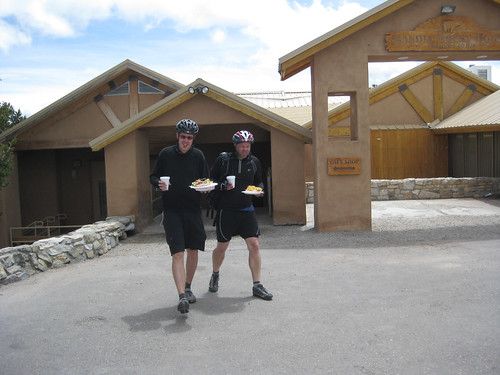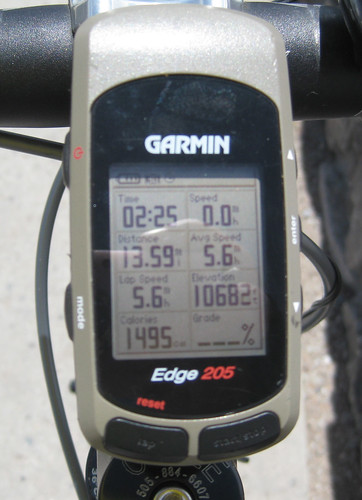It has long been my tradition to celebrate my birthday by riding my age, but this year’s attempt got a bit fouled up.
I’m not really old enough for my current age to be a huge challenge, so I usually try to dress it up a bit for fun. Last year, for example, I spent the day circumnavigating all the roundabouts in Albuquerque by bicycle. This year, for my 50th birthday, I planned to ride Sandia Crest, the great mountain that looms to Albuquerque’s east. It’s got a wonderful road up the back side, one of those that gets a green dotted line on the tourist maps, up through lovely pine forests and a rolling geology lesson. It’s the highest paved road in New Mexico, and one of the highest paved roads in the United States. It’s also a bit of a beast on a bike, but I figured it would be manageable if I just got enough weekend climbing miles in. The plan was to ride from my house to the crest and back, something like 70 miles with about a mile of elevation gain.
Big “if”, it turned out. It’s been an incredibly busy spring (busy meaning not much time on the bike). A couple of weeks ago I concluded I just wasn’t ready and told my riding buddies I was switching to a more modest ride. It would be 50 in the mountains, I decided, but we’d leave the Crest for another day. That night, Scot sent this email:
John…I thought about it on the way home, and I’m going to humbly suggest you stick to the Crest Ride for your birthday…it’s not as hard as you think and seeing the city from the top would be birthday-stellar. ..it’s doable.

That’s Scot on the right. From left: Andrew, Taylor and myself.
The cheat was driving to the base of the main climb, so we only had to climb 3,800 feet (1,200 meters) instead of the full thing. Except Andrew, who is an animal and rode all the way up from town.

This is Andrew and Taylor with enormous plates of nachos sold in the little gift shop at the Crest.

This is my GPS with all the pertinent data, but the real key is the right-hand column, second from the bottom, “Elevation 10,682”, the first time I’ve ridden it to quintuple digits.
It was only something like 27 miles, so it doesn’t count as the official ride-my-age thing, but it was one of the finest rides I’ve ever been on, really “birthday stellar”, and I’d like to thank Andrew, Taylor and Scot for helping me celebrate with some semblance of style.
Plus, I think I’ve got them conned into going out next weekend to Oak Flat, just to be sure we’ve got the full 50 covered.




